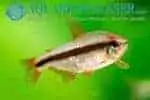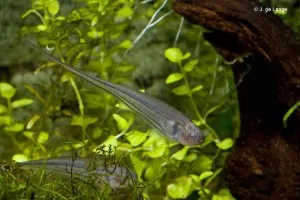Hyphessobrycon piranga
Hyphessobrycon piranga was only described in 2018 by Camelier, Dagosta & Marinho. The genus name Hyphessobrycon can be broken into two ancient Greek words. Hyphesson means “a little smaller” and “bryko” means biter. Together they form the family name “small biter”. The species name piranga comes from the Brazilian Indian language Tupi. It means “red”, a reference to the remarkable red color of the males. It is also a reference to the bird genus Piranga of which the males are also colored red and the females yellow.
Before they were officially described, they were already available on the market under the unusual name “Hyphessobrycon sp. non-red devil “.
Description
De grondkleur van Hyphessobrycon piranga is een beetje beige/grijs/gelig. Over de flank loopt één dikke donkerbruine streep, van de neus, door het oog tot en met de staartwortel. De mannen krijgen rode vinnen en wat meer vaag rood op het lichaam. De vrouwen krijgen deze rode kleur niet en zijn meer geel van kleur. Ze lijken meer op de Zwarte Neon (Hyphessobrycon herbertaxelrodi) of de Hyphessobrycon nigricinctus.
In the wild, this species reaches a maximum total length of around 2.5 centimeters, but in the aquarium they can grow to around 3.5 centimeters in total length.
Biotope
Rio Verde and Rio Juruena drainage, upper Rio Tapajós basin, Mato Grosso, Brazil. They live in clear, flowing water with medium to fast currents. They live above pebbles, sand, and organic waste.
Diet
Hyphessobrycon piranga is an omnivore. You should feed them a variety of live and frozen food as well as some spirulina and other vegetable foods. They will also eat flakes and small granules for omnivorous fish.
The Aquarium
This small-sized characid does not need a very large aquarium. Of course, they are schooling fish, so you keep them in a school of at least 7 specimens, but preferably even more. A 50-centimeter aquarium would suffice for a small school.
Decorate the aquarium with a substrate of sand, gravel or pebbles. They live in areas with an abundance of plants, use lots of them in your aquarium. You can also choose to put some leaves on the bottom.
It is a fairly easy species to keep. They have no special demands on the water, although a little current to imitate the biotope will not hurt. Unfortunately, I have not been able to find much about the temperatures and water values, but a temperature of around 24 to 25 degrees Celsius and a pH of 6.5 to 7.5 should be quite correct.
Breeding Hyphessobrycon piranga
Net als de andere Hyphessobrycon soorten is dit een vrijlegger. In het aquarium zullen ze tussen fijnbladerige planten zoals Javamos geregeld een paar eieren afzetten. Met een beetje geluk zal er af en toe een jong overleven en opgroeien maar de kans is niet heel groot. De ouders eten de eigen eieren en jongen.
If you really want to breed this species a breeding aquarium is needed. Set up an aquarium without other species and add Javamos. Use a sponge filter as a filter so that the young fish are not sucked up and they can pick food particles from the filter.
Add the females first to the aquarium and condition them with live food such as black mosquito larvae. If the females are full of eggs, you add the males. The next morning they will probably already lay eggs. The parents must then be removed.
You can feed the tiny fry as soon as they swim free. Start with infusoria, Paramecium, or for example liquifry. As soon as they grow a little bigger you can switch to micro worms and later newly hatched brine shrimp.
Video
Author
John de Lange
Copyright images
Resources
Journal of Fish Biology (2018): New remarkable sexually dimorphic miniature species of Hyphessobrycon (Characiformes: Characidae) from the upper Rio Tapajós basin.
AquariumGlaser.de

















Reviews
There are no reviews yet.